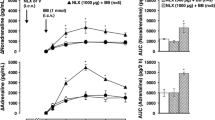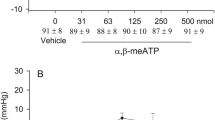Summary
Isolated tail arteries of rats were perfused and field-stimulated every 2 min with 2 pulses at 1 Hz. Different opioid peptides depressed the contractile responses to stimulation; their concentration-response curves showed a maximum at about 40% inhibition. The rank order of potency of the peptides was β-endorphin (IC50 = 97 nmol/1) ≅ BAM-22P > FK-33824 > DAGO > [d-Ala2,d-Leu5]-enkephalin ⩾ metorphamide > dynorphin A-(1-13) ≅[Met5]enkephalin. All these substances have in common a certain activity at opioid μ-receptors, although the enkephalins are preferential δ-, and the dynorphins preferential κ-agonists. However, the selective δ-agonist [d-Pen2,l-Pen5]enkephalin was ineffective at up to 10 μmol/l, and the κ-agonists ethylketocyclazocine and U-50488 acted only at concentrations higher than 3 μmol/l. Whereas the effects of β-endorphin, DAGO and [d-Ala2,d-Leu5]enkephalin could be reduced by the μ-preferential antagonist naloxone, the effects of ethylketocyclazocine and U-50488 were not changed. The δ-selective antagonist ICI 174864 did not influence the action of [d-Ala2,d-Leu5]enkephalin. Naloxone in a concentration (1 μmol/l) which nearly abolished the effect of DAGO 3 μmol/l, slightly enhanced responses to stimulation. Neither β-endorphin nor DAGO influenced vasoconstriction evoked by the application of noradrenaline or adenosine triphosphate; U-50488 reduced it. In arteries preincubated with [3H]noradrenaline DAGO depressed, whereas naloxone enhanced the tritium overflow and vasoconstriction evoked by field stimulation (0.4 Hz, 24 pulses every 14 min). In addition, naloxone antagonized the effect of DAGO. We suggest that the axon terminals of postganglionic sympathetic neurones in the rat tail artery possess β-endorphin-sensitive opioid receptors of the ɛ-type. The activation of these receptors by exogenous or endogenous opioids inhibits the release of the neuroeffector transmitter.
Similar content being viewed by others
References
Chaminade M, Foutz AS, Rossier J (1984) Co-release of enkephalins and precursors with catecholamines from the perfused cat adrenal gland in situ. J Physiol 353:157–169
Chavkin C, James IF, Goldstein A (1982) Dynorphin is a specific endogenous ligand of the κ opioid receptor. Science 215:413–415
Cheng Y-C, Prusoff WH (1973) Relationship between the inhibition constant (KB) and the concentration of inhibitor which causes 50 percent inhibition (I50) of an enzymatic reaction. Biochem Pharmacol 22:3099–3108
Corbett AD, Gillan MGC, Kosterlitz HW, McKnight AT, Paterson SJ, Robson LE (1984) Selectivities of opioid peptide analogues as agonists and antagonists at the δ-receptor. Br J Pharmacol 83:271–279
Cotton R, Giles MG, Miller L, Shaw JS, Timms D (1984) ICI 174864: a highly selective antagonist for the opioid δ-receptor. Eur J Pharmacol 97:331–332
Cowie AL, Kosterlitz HW, Waterfield AA (1978) Factors influencing the release of acetylcholine from the myenteric plexus of the ileum of the guinea-pig and rabbit. Br J Pharmacol 64:565–580
Garzon J, Schultz R, Herz A (1985) Evidence for the ɛ-type of opioid receptor in the rat vas deferens. Mol Pharmacol 28: 1–9
Gillan MGC, Kosterlitz HW, Paterson SJ (1980) Comparison of the binding characteristics of tritiated opiates and opioid peptides. Br J Pharmacol 70:481–490
Goldstein A, James IF (1984) Site-directed alkylation of multiple opioid receptors. II. Pharmacological selectivity. Mol Pharmacol 25:343–348
Govoni S, Hanbauer I, Hexum TD, Yang H-YT, Kelly GD, Costa E (1981) In vivo characterization of the mechanisms that secrete enkephalin-like peptides stored in dog adrenal medulla. Neuropharmacology 20:639–645
Guillemin R, Vargo T, Rossier J, Minick S, Ling N, Rivier C, Vale W, Bloom F (1977) β-Endorphin and adrenocorticotropin are secreted concomitantly by the pituitary gland. Science 197: 1367–1369
Höllt V (1983) Multiple endogenous opioid peptides. Trends Neurosci 6:24–26
Huidobro-Toro JP, Caturay EM, Ling N, Lee NM, Loh HH, Way EL (1982) Studies on the structural prerequisites for the activation of the β-endorphin receptor on the rat vas deferens. J Pharmacol Exp Ther 222:262–269
Illes P, Bettermann R, Ramme D (1986) Sympathoinhibitory opioid receptors in the cardiovascular system. In: Buckley JP, Ferrario CM (eds) Brain peptides and catecholamines in cardiovascular regulation in normal and disease states. Raven, New York (in press)
Illes P, Pfeiffer N (1985) Regulation of blood pressure by peripheral opioid mechanisms. In: Bevan JA, Godfraind T, Maxwell RA, Stoclet JC, Worcel M (eds) Vascular neuroeffector mechanisms. Elsevier, Amsterdam, pp 175–180
Illes P, Pfeiffer N, von Kugelgen I, Starke K (1985) Presynaptic opioid receptor subtypes in the rabbit ear artery. J Pharmacol Exp Ther 232:526–533
Illes P, Ramme D, Starke K (1986) Presynaptic opioid δ-receptors in the rabbit mesenteric artery. J Physiol 379:217–228
Illes P, Zieglgdnsberger W, Herz A (1980) Calcium reverses the inhibitory action of morphine on neuroeffector transmission in the mouse vas deferens. Brain Res 191:511- 522
Johnson N, Houghton RA, Pasternak GW (1982) Binding of 3H-β-endorphin in rat brain. Life Sci 31:1381–1384
Kosterlitz HW (1985) Opioid peptides and their receptors. Proc Roy Soc Lond B 225:27–40
Kosterlitz HW, Paterson SJ, Robson LE (1981) Characterization of the κ-subtype of the opiate receptor in the guinea-pig brain. Br J Pharmacol 73:939–949
Lang RE, Hermann K, Dietz R, Gaida W, Ganten D, Kraft K, Unger T (1983) Evidence for the presence of enkephalins in the heart. Life Sci 32:399–406
Lord JAH, Waterfield AA, Hughes J, Kosterlitz HW (1977) Endogenous opioid peptides: multiple agonists and receptors. Nature 267:495–499
Lundberg JM, Hökfelt T, Ånggard A, Uvnäs-Wallensten K, Brimijoin S, Brodin E, Fahrenkrug J (1980) Peripheral peptide neurons: distribution, axonal transport, and some aspects on possible function. Adv Biochem Psychopharmacol 22:25–36
Matsuo H, Miyata A, Mizuno K (1983) Novel C-terminally amidated opioid peptide in human phaeochromocytoma tumour. Nature 305:721–723
McKnight AT, Corbett AD, Marcoli M, Kosterlitz HW (1985) The opioid receptors in the hamster vas deferens are of the δ-type. Neuropharmacology 24:1011–1017
Medgett IC, Langer SZ (1984) Heterogeneity of smooth muscle alpha adrenoceptors in rat tail artery in vitro. J Pharmacol Exp Ther 229:823–830
Mizuno K, Minamino N, Kangawa K, Matsuo H (1980) A new family of endogenous “big” Met-enkephalins from bovine adrenal medulla: purification and structure of docosa-(BAM-22P) and eicosapeptide (BAM-20P) with very potent opiate activity. Biochem Biophys Res Comm 97:1283–1290
Mosberg HI, Hurst R, Hruby VJ, Gee K, Yamamura HI, Galligan JJ, Burks TF (1983) Bis-penicillamine enkephalins possess highly improved specificity towards opioid receptors. Proc Natl Acad Sci USA 80:5871–5874
Oka T, Negishi K, Suda M, Matsumiya T, Inazu T, Ueki M (1980) Rabbit vas deferens: a specific bioassay for opioid κ-receptor agonists. Eur J Pharmacol 73:235–236
Paterson SJ, Robson LE, Kosterlitz HW (1983) Classification of opioid receptors. Br Med Bull 39:31–36
Pelletier G, Leclerc R, Labrie F, Cote J, Chretien M, Lis M (1977) Immunohistochemical localization of β-lipotropic hormone in the pituitary. Endocrinology 100:770–776
Schultzberg M, Hökfelt T, Nilsson G, Terenius L, Rehfeld JF, Brown M, Elde R, Goldstein M, Said S (1980) Distribution of peptide and catecholamine-containing neurones in the gastrointestinal tract of rat and guinea-pig: immunohistochemical studies with antisera to substance P, vasoactive intestinal polypeptide, enkephalins, somatostatin, gastrin/cholecystokinin, neurotensin and dopamine β-hydroxylase. Neuroscience 5:689–744
Schulz R, Faase E, Wüster M, Herz A (1979) Selective receptors for β-endorphin on the rat vas deferens. Life Sci 24:843–850
Schulz R, Wüster M, Herz A (1981) Pharmacological characterization of the ɛ-opiate receptor. J Pharmacol Exp Ther 216:604–606
Smith CFC, Rance MJ (1983) Opiate receptors in the rat vas deferens. Life Sci 33: Suppl I, 327–330
Smyth DG (1983) β-Endorphin and related peptides in pituitary, brain, pancreas and antrum. Br Med Bull 39:25–30
Sneddon P, Burnstock G (1985) ATP as a co-transmitter in rat tail artery. Eur J Pharmacol 106:149–152
Starke K (1981) α-Adrenoceptor subclassification. Rev Physiol Biochem Pharmacol 88:199–236
Vidal M, Hicks PE, Langer SZ (1986) Differential effects of α,β-methylene ATP on responses to nerve stimulation in SHR and WKY tail arteries. Naunyn-Schmiedeberg's Arch Pharmacol 332:384–390
von Kugelgen I, Illes P, Wolf D, Starke K (1985) Presynaptic inhibitory opioid δ- and κ-receptors in a branch of the rabbit ileocolic artery. Eur J Pharmacol 118:97–105
VonVoigtlander PF, Lahti RA, Ludens JH (1983) U-50488: a selective and structurally novel non-mu (kappa) opioid agonist. J Pharmacol Exp Ther 224:7–12
Weber E, Esch FS, Böhlen P, Paterson S, Corbett AD, McKnight AT, Kosterlitz HW, Barchas JD, Evans CJ (1983) Metorphamide: isolation, structure and biologic activity of an amidated opioid octapeptide from bovine brain. Proc Natl Acad Sci USA 80:7362–7366
Weihe E, McKnight AT, Corbett AD, Kosterlitz HW (1985) Proenkephalin-and prodynorphin-derived opioid peptides in guinea-pig heart. Neuropeptides 5:453–456
Wüster M, Schulz R, Herz A (1980) The direction of opioid agonists towards μ, δ- and ɛ-receptors in the vas deferens of the mouse and the rat. Life Sci 27:163–170
Wüster M, Schulz R, Herz A (1981) Multiple opiate receptors in peripheral tissue preparations. Biochem Pharmacol 30:1883–1887
Xiang JZ, Archelos J, Lang RE (1984) Enkephalins in the heart. Clin Exp Hyper Theory and Practice A6 (10&11):1883–1888
Author information
Authors and Affiliations
Additional information
This work was supported by the Deutsche Forschungsgemeinschaft (SFB 325)
Send offprint requests to P. Illes at the above address
Rights and permissions
About this article
Cite this article
Illes, P., Bettermann, R., Brod, I. et al. β-endorphin-sensitive opioid receptors in the rat tail artery. Naunyn-Schmiedeberg's Arch Pharmacol 335, 420–427 (1987). https://doi.org/10.1007/BF00165557
Received:
Accepted:
Issue Date:
DOI: https://doi.org/10.1007/BF00165557




